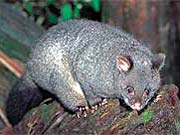New Mammal Species Identified in Australia

In the current crisis of global biodiversity loss, the discovery of new species is a welcome addition. But the recent finding that the mountain brushtail possum, an arboreal marsupial mammal of Australian wet forests, is actually made up of two species also poses new conservation challenges.
The new species is proposed in an article in the latest Australian Journal of Zoology (Volume 50, Issue 4), authored by Earthwatch-supported biologist Dr. David Lindenmayer (Australian National University) and colleagues. “Geographic dimorphism in the Mountain Brushtail Possum (Trichosurus caninus) – the case for a new species,” describes how the northern and southern populations of the mountain brushtail possum are both morphologically and genetically distinct.
“This article represents the last 10 years of data on the genetics and morphology of mountain brushtails where we have worked on them,” said Lindenmayer, principal investigator of the Earthwatch-supported Australia’s Forest Marsupials project. “We knew we had two species on our hands last year when we got the genetic data to add to the morphology data.”
A hiker in the woods might not distinguish the two species, but northern mountain brushtails in the forests of New South Wales and Queensland have smaller ears, shorter feet, and a longer, brushier tail than those in Victorian forests to the south. Although there is variability in both populations, years of morphological data collected by Lindenmayer and colleagues confirm that these differences are statistically significant.
Genetic distances of 2.7% to 3% between the southern and northern populations of mountain brushtails further support their species status. Genetic data was collected last year when the scientists were investigating biological controls for the related common brushtail.
“We were trying to find a parasite or disease in mountain brushtail to help control closely related common brushtails, which are a serious pest in New Zealand,” said Lindenmayer.
The article proposes calling the northern species the short-eared possum, reflecting its distinctly smaller ear, although it would retain the scientific name Trichosurus caninus. This is because the species was originally named using specimens from the northern population in the 1830s. The southern species will retain the common name, mountain brushtail possum, but gain a new scientific name, Trichosurus cunninghami.
Both mountain brushtail and short-eared possums require old-growth forests, where they live in the hollows of large dead trees, a habitat type that is increasingly threatened by intensive logging practices in Australia. The revelation that these animals represent two species means that their populations and ranges are effectively half as large as that of the original mountain brushtail.
“Our findings have major conservation implications, as the two new species need conserving more carefully,” said Lindenmayer. “Conservation is needed for two species now, not one.”
Earthwatch teams working with Lindenmayer continue to collect vital information on the habitat needs of mountain brushtail possums (Trichosurus cunninghami) in Victorian forsests. The discovery that this represents a new species with a more limited range makes their work even more critical.
Media Contact
More Information:
http://www.earthwatch.orgAll latest news from the category: Life Sciences and Chemistry
Articles and reports from the Life Sciences and chemistry area deal with applied and basic research into modern biology, chemistry and human medicine.
Valuable information can be found on a range of life sciences fields including bacteriology, biochemistry, bionics, bioinformatics, biophysics, biotechnology, genetics, geobotany, human biology, marine biology, microbiology, molecular biology, cellular biology, zoology, bioinorganic chemistry, microchemistry and environmental chemistry.
Newest articles

Not Lost in Translation: AI Increases Sign Language Recognition Accuracy
Additional data can help differentiate subtle gestures, hand positions, facial expressions The Complexity of Sign Languages Sign languages have been developed by nations around the world to fit the local…

Breaking the Ice: Glacier Melting Alters Arctic Fjord Ecosystems
The regions of the Arctic are particularly vulnerable to climate change. However, there is a lack of comprehensive scientific information about the environmental changes there. Researchers from the Helmholtz Center…

Global Genetic Insights into Depression Across Ethnicities
New genetic risk factors for depression have been identified across all major global populations for the first time, allowing scientists to predict risk of depression regardless of ethnicity. The world’s…



